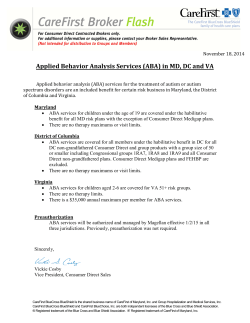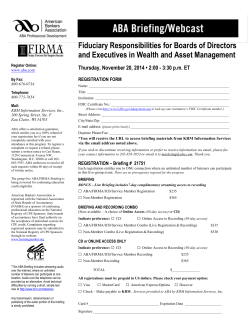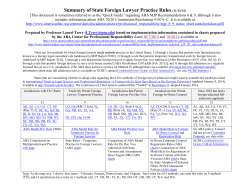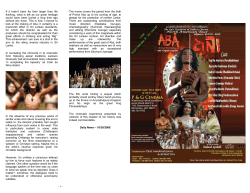
2014-2015 Chapter 3 of ABA Standards and Rules of Procedure for
CHAPTER 3 Program of Legal Education Standard 301. OBJECTIVES OF PROGRAM OF LEGAL EDUCATION (a) A law school shall maintain a rigorous program of legal education that prepares its students, upon graduation, for admission to the bar and for effective, ethical, and responsible participation as members of the legal profession. (b) A law school shall establish and publish learning outcomes designed to achieve these objectives. Standard 302. LEARNING OUTCOMES A law school shall establish learning outcomes that shall, at a minimum, include competency in the following: (a) Knowledge and understanding of substantive and procedural law; (b) Legal analysis and reasoning, legal research, problem-solving, and written and oral communication in the legal context; (c) Exercise of proper professional and ethical responsibilities to clients and the legal system; and (d) Other professional skills needed for competent and ethical participation as a member of the legal profession. 15 ABA_Standard_5th pass_Rulesreformatted.indd 15 8/16/2014 10:18:04 AM ABA Standards and Rules of Procedure for Approval of Law Schools 2014-2015 16 Interpretation 302-1 For the purposes of Standard 302(d), other professional skills are determined by the law school and may include skills such as, interviewing, counseling, negotiation, fact development and analysis, trial practice, document drafting, conflict resolution, organization and management of legal work, collaboration, cultural competency, and self-evaluation. Interpretation 302-2 A law school may also identify any additional learning outcomes pertinent to its program of legal education. Standard 303. CURRICULUM (a) A law school shall offer a curriculum that requires each student to satisfactorily complete at least the following: (1) one course of at least two credit hours in professional responsibility that includes substantial instruction in the history, goals, structure, values, and responsibilities of the legal profession and its members; (2) one writing experience in the first year and at least one additional writing experience after the first year, both of which are faculty supervised; and (3) one or more experiential course(s) totaling at least six credit hours. An experiential course must be a simulation course, a law clinic, or a field placement. To satisfy this requirement, a course must be primarily experiential in nature and must: (i) integrate doctrine, theory, skills, and legal ethics, and engage students in performance of one or more of the professional skills identified in Standard 302; (ii) develop the concepts underlying the professional skills being taught; (iii) provide multiple opportunities for performance; and (iv) provide opportunities for self-evaluation. (b) A law school shall provide substantial opportunities to students for: (1) law clinics or field placement(s); and (2) student participation in pro bono legal services, including law-related public service activities. Interpretation 303-1 A law school may not permit a student to use a course to satisfy more than one requirement under this Standard. For example, a course that includes a writing experience used to satisfy the upper-class writing requirement [see 303(a)(2)] cannot be counted as one of the experiential courses required in Standard 303(a)(3). ABA_Standard_5th pass_Rulesreformatted.indd 16 8/16/2014 10:18:04 AM 17 ABA Standards and Rules of Procedure for Approval of Law Schools 2014-2015 Interpretation 303-2 Factors to be considered in evaluating the rigor of a writing experience include the number and nature of writing projects assigned to students, the form and extent of individualized assessment of a student’s written products, and the number of drafts that a student must produce for any writing experience. Interpretation 303-3 Rule 6.1 of the ABA Model Rules of Professional Conduct encourages lawyers to provide pro bono legal services primarily to persons of limited means or to organizations that serve such persons. In addition, lawyers are encouraged to provide pro bono law-related public service. In meeting the requirement of Standard 303(b)(2), law schools are encouraged to promote opportunities for law student pro bono service that incorporate the priorities established in Model Rule 6.1. In addition, law schools are encouraged to promote opportunities for law students to provide over their law school career at least 50 hours of pro bono service that complies with Standard 303(b)(2). Pro bono and public service opportunities need not be structured to accomplish any of the outcomes required by Standard 302. Standard 303(b)(2) does not preclude the inclusion of credit-granting activities within a law school’s overall program of law-related pro bono opportunities so long as law-related non-credit bearing initiatives are also part of that program. Interpretation 303-4 Law-related public service activities include (i) helping groups or organizations seeking to secure or protect civil rights, civil liberties, or public rights; (ii) helping charitable, religious, civic, community, governmental, and educational organizations not able to afford legal representation; (iii) participating in activities providing information about justice, the law or the legal system to those who might not otherwise have such information; and (iv) engaging in activities to enhance the capacity of the law and legal institutions to do justice. Standard 304. SIMULATION COURSES AND LAW CLINICS (a) A simulation course provides substantial experience not involving an actual client, that (1) is reasonably similar to the experience of a lawyer advising or representing a client or engaging in other lawyering tasks in a set of facts and circumstances devised or adopted by a faculty member, and (2) includes the following: (i) direct supervision of the student’s performance by the faculty member; (ii) opportunities for performance, feedback from a faculty member, and self-evaluation; and (iii) a classroom instructional component. (b) A law clinic provides substantial lawyering experience that (1) involves one or more actual clients, and (2) includes the following: (i) advising or representing a client; (ii) direct supervision of the student’s performance by a faculty member; (iii) opportunities for performance, feedback from a faculty member, and self-evaluation; and (iv) a classroom instructional component. ABA_Standard_5th pass_Rulesreformatted.indd 17 8/16/2014 10:18:04 AM ABA Standards and Rules of Procedure for Approval of Law Schools 2014-2015 18 Standard 305. FIELD PLACEMENTS AND OTHER STUDY OUTSIDE THE CLASSROOM (a) A law school may grant credit toward the J.D. degree for courses that involve student participation in studies or activities in a format that does not involve attendance at regularly scheduled class sessions, including courses approved as part of a field placement program, moot court, law review, and directed research. (b) Credit granted for such a course shall be commensurate with the time and effort required and the anticipated quality of the educational experience of the student. (c) Each student’s educational achievement in such a course shall be evaluated by a faculty member. When appropriate a school may use faculty members from other law schools to supervise or assist in the supervision or review of a field placement program. (d) The studies or activities shall be approved in advance and periodically reviewed following the school’s established procedures for approval of the curriculum. (e) A field placement program shall include: (1) a clear statement of its goals and methods, and a demonstrated relationship between those goals and methods and the program in operation; (2) adequate instructional resources, including faculty teaching in and supervising the program who devote the requisite time and attention to satisfy program goals and are sufficiently available to students; (3) a clearly articulated method of evaluating each student’s academic performance involving both a faculty member and the site supervisor; (4) a method for selecting, training, evaluating, and communicating with site supervisors; (5) for field placements that award three or more credit hours, regular contact between the faculty supervisor or law school administrator and the site supervisor to assure the quality of the student educational experience, including the appropriateness of the supervision and the student work; (6) a requirement that each student has successfully completed instruction equivalent to 28 credit hours toward the J.D. degree before participation in the field placement program; and (7) opportunities for student reflection on their field placement experience, through a seminar, regularly scheduled tutorials, or other means of guided reflection. Where a student may earn three or more credit hours in a field placement program, the opportunity for student reflection must be provided contemporaneously. (f) A law school that has a field placement program shall develop, publish, and communicate to students and site supervisors a statement that describes the educational objectives of the program. ABA_Standard_5th pass_Rulesreformatted.indd 18 8/16/2014 10:18:04 AM 19 ABA Standards and Rules of Procedure for Approval of Law Schools 2014-2015 Interpretation 305-1 Regular contact may be achieved through in-person visits or other methods of communication that will assure the quality of the student educational experience. Interpretation 305-2 A law school may not grant credit to a student for participation in a field placement program for which the student receives compensation. This Interpretation does not preclude reimbursement of reasonable out-ofpocket expenses related to the field placement. Standard 306. DISTANCE EDUCATION (a) A distance education course is one in which students are separated from the faculty member or each other for more than one-third of the instruction and the instruction involves the use of technology to support regular and substantive interaction among students and between the students and the faculty member, either synchronously or asynchronously. (b) Credit for a distance education course shall be awarded only if the academic content, the method of course delivery, and the method of evaluating student performance are approved as part of the school’s regular curriculum approval process. (c) A law school shall have the technological capacity, staff, information resources, and facilities necessary to assure the educational quality of distance education. (d) A law school may award credit for distance education and may count that credit toward the 64 credit hours of regularly scheduled classroom sessions or direct faculty instruction required by Standard 310(b) if: (1) there is opportunity for regular and substantive interaction between faculty member and student and among students; (2) there is regular monitoring of student effort by the faculty member and opportunity for communication about that effort; and (3) the learning outcomes for the course are consistent with Standard 302. (e) A law school shall not grant a student more than a total of 15 credit hours toward the J.D. degree for courses qualifying under this Standard. (f) A law school shall not enroll a student in courses qualifying for credit under this Standard until that student has completed instruction equivalent to 28 credit hours toward the J.D. degree. (g) A law school shall establish an effective process for verifying the identity of students taking distance education courses and that also protects student privacy. If any additional student charges are associated with verification of student identity, students must be notified at the time of registration or enrollment. ABA_Standard_5th pass_Rulesreformatted.indd 19 8/16/2014 10:18:04 AM ABA Standards and Rules of Procedure for Approval of Law Schools 2014-2015 20 Interpretation 306-1 Technology used to support a distance education course may include, for example: (a) The Internet; (b) One-way and two-way transmissions through open broadcast, closed circuit, cable, microwave, broadband lines, fiber optics, satellite, or wireless communications devices; (c) Audio and video conferencing; or (d) Video cassettes, DVDs, and CD-ROMs, if the cassettes, DVDs, or CD–ROMs are used in a course in conjunction with any of the technologies listed in paragraphs (a) through (c). Interpretation 306-2 Methods to verify student identity as required in Standard 306(g) include, but are not limited to (i) a secure login and pass code, (ii) proctored examinations, and (iii) other technologies and practices that are effective in verifying student identity. As part of the verification process, a law school shall verify that the student who registers for a class is the same student that participates and takes any examinations for the class. Standard 307. STUDIES, ACTIVITIES, AND FIELD PLACEMENTS OUTSIDE THE UNITED STATES (a) A law school may grant credit for (1) studies or activities outside the United States that are approved in accordance with the Rules of Procedure and Criteria as adopted by the Council and (2) field placements outside the United States that meet the requirements of Standard 305 and are not held in conjunction with studies or activities that are approved in accordance with the Rules of Procedure and Criteria as adopted by the Council. (b) The total credits for student participation in such studies or activities may not exceed one-third of the credits required for the J.D. degree. Interpretation 307-1 The three Criteria adopted by the Council are the Criteria for Approval of Foreign Summer and Intersession Programs Established by ABA-Approved Law Schools, the Criteria for Approval of Foreign Semester and Year-Long Study Abroad Programs Established by ABA-Approved Law Schools, and the Criteria for Accepting Credit for Student Study at a Foreign Institution. Interpretation 307-2 For purposes of Standard 307, a brief visit to a country outside the United States that is part of a course offered and based primarily at the law school and approved through the school’s regular curriculum approval process is not considered to be studies outside the United States. Standard 308. ACADEMIC STANDARDS (a) A law school shall adopt, publish, and adhere to sound academic standards, including those for good standing, academic integrity, graduation, and dismissal. (b) A law school shall adopt, publish, and adhere to written due process policies with regard to taking any action that adversely affects the good standing or graduation of a student. ABA_Standard_5th pass_Rulesreformatted.indd 20 8/16/2014 10:18:04 AM 21 ABA Standards and Rules of Procedure for Approval of Law Schools 2014-2015 Standard 309. ACADEMIC ADVISING AND SUPPORT (a) A law school shall provide academic advising for students that communicates effectively the school’s academic standards and graduation requirements, and that provides guidance on course selection. (b) A law school shall provide academic support designed to afford students a reasonable opportunity to complete the program of legal education, graduate, and become members of the legal profession. Standard 310. DETERMINATION OF CREDIT HOURS FOR COURSEWORK (a) A law school shall adopt, publish, and adhere to written policies and procedures for determining the credit hours that it awards for coursework. (b) A “credit hour” is an amount of work that reasonably approximates: (1) not less than one hour of classroom or direct faculty instruction and two hours of out-of-class student work per week for fifteen weeks, or the equivalent amount of work over a different amount of time; or (2) at least an equivalent amount of work as required in subparagraph (1) of this definition for other academic activities as established by the institution, including simulation, field placement, clinical, co-curricular, and other academic work leading to the award of credit hours. Interpretation 310-1 For purposes of this Standard, fifty minutes suffices for one hour of classroom or direct faculty instruction. An “hour” for out-of-class student work is sixty minutes. The fifteen-week period may include one week for a final examination. Interpretation 310-2 A school may award credit hours for coursework that extends over any period of time, if the coursework entails no less than the minimum total amounts of classroom or direct faculty instruction and of out-of-class student work specified in Standard 310(b). Standard 311. ACADEMIC PROGRAM AND ACADEMIC CALENDAR (a) A law school shall have an academic year of not fewer than 140 days on which classes and examinations are regularly scheduled in the law school, extending into not fewer than eight calendar months. The law school shall provide adequate time for reading periods and breaks, but such time does not count toward the 140-day academic year requirement. (b) A law school shall require, as a condition for graduation, successful completion of a course of study of not fewer than 83 credit hours. At least 64 of these credit hours shall be in courses that require attendance in regularly scheduled classroom sessions or direct faculty instruction. (c) A law school shall require that the course of study for the J.D. degree be completed no earlier than 24 months and, except in extraordinary circumstances, no later than 84 months after a ABA_Standard_5th pass_Rulesreformatted.indd 21 8/16/2014 10:18:04 AM ABA Standards and Rules of Procedure for Approval of Law Schools 2014-2015 22 student has commenced law study at the law school or a law school from which the school has accepted transfer credit. (d) A law school shall not permit a student to be enrolled at any time in coursework that exceeds 20 percent of the total credit hours required by that school for graduation. (e) Credit for a J.D. degree shall only be given for course work taken after the student has matriculated in a law school. A law school may not grant credit toward the J.D. degree for work taken in a pre-admission program. (f) A law school shall adopt, publish, and adhere to a written policy requiring regular class attendance. Interpretation 311-1 A law school may not count more than five class days each week toward the 140-day requirement. Interpretation 311-2 (a) In calculating the 64 credit hours of regularly scheduled classroom sessions or direct faculty instruction for the purpose of Standard 311(b), the credit hours may include: (1) Credit hours earned by attendance in regularly scheduled classroom sessions or direct faculty instruction; (2) Credit hours earned by participation in a simulation course or law clinic in compliance with Standard 304; (3) Credit hours earned through distance education in compliance with Standard 306; and (4) Credit hours earned by participation in law-related studies or activities in a country outside the United States in compliance with Standard 307. (b) In calculating the 64 credit hours of regularly scheduled classroom sessions or direct faculty instruction for the purpose of Standard 311(b), the credit hours shall not include any other coursework, including, but not limited to: (1) Credit hours earned through field placements and other study outside of the classroom in compliance with Standard 305; (2) Credit hours earned in another department, school, or college of the university with which the law school is affiliated, or at another institution of higher learning; (3) Credit hours earned for participation in co-curricular activities such as law review, moot court, and trial competition; and (4) Credit hours earned by participation in studies or activities in a country outside the United States in compliance with Standard 307 for studies or activities that are not law-related. Interpretation 311-3 Whenever a student is permitted on the basis of extraordinary circumstances to exceed the 84-month program limitation in Standard 311(c), the law school shall place in the student’s file a statement signed by an appropriate law school official explaining the extraordinary circumstances leading the law school ABA_Standard_5th pass_Rulesreformatted.indd 22 8/16/2014 10:18:04 AM 23 ABA Standards and Rules of Procedure for Approval of Law Schools 2014-2015 to permit an exception to this limitation. Such extraordinary circumstances, for example, might include an interruption of a student’s legal education because of an illness, family exigency, or military service. Interpretation 311-4 For purposes of Standard 311(c), the time for determining the commencement of law study is ordinarily the time when a student commences law study at any institution. For example, if a law school accepts transfer credit from another institution, the time begins when the student commenced study at the law school from which the transfer credit is accepted. If a law school accepts a student who has completed law studies at a law school outside the United States as permitted under Standard 505, only the time commensurate with the amount of credit given counts toward the length of study requirements of Standard 311(c). Standard 312. REASONABLY COMPARABLE OPPORTUNITIES A law school providing more than one enrollment or scheduling option shall ensure that all students have reasonably comparable opportunities for access to the law school’s program of legal education, courses taught by full-time faculty, student services, co-curricular programs, and other educational benefits. Identical opportunities are not required. Standard 313. DEGREE PROGRAMS IN ADDITION TO J.D. A law school may not offer a degree program other than its J.D. degree program unless: (a) the law school is fully approved; (b) the Council has granted acquiescence in the program; and (c) the degree program will not interfere with the ability of the law school to operate in compliance with the Standards and to carry out its program of legal education. Interpretation 313-1 Acquiescence in a degree program other than the J.D. degree is not an approval of the program itself and, therefore, a school may not announce that the program is approved by the Council. Standard 314. ASSESSMENT OF STUDENT LEARNING A law school shall utilize both formative and summative assessment methods in its curriculum to measure and improve student learning and provide meaningful feedback to students. Interpretation 314-1 Formative assessment methods are measurements at different points during a particular course or at different points over the span of a student’s education that provide meaningful feedback to improve student learning. Summative assessment methods are measurements at the culmination of a particular course or at the culmination of any part of a student’s legal education that measure the degree of student learning. Interpretation 314-2 A law school need not apply multiple assessment methods in any particular course. Assessment methods are likely to be different from school to school. Law schools are not required by Standard 314 to use any particular assessment method. ABA_Standard_5th pass_Rulesreformatted.indd 23 8/16/2014 10:18:04 AM ABA Standards and Rules of Procedure for Approval of Law Schools 2014-2015 24 Standard 315. EVALUATION OF PROGRAM OF LEGAL EDUCATION, LEARNING OUTCOMES, AND ASSESSMENT METHODS The dean and the faculty of a law school shall conduct ongoing evaluation of the law school’s program of legal education, learning outcomes, and assessment methods; and shall use the results of this evaluation to determine the degree of student attainment of competency in the learning outcomes and to make appropriate changes to improve the curriculum. Interpretation 315-1 Examples of methods that may be used to measure the degree to which students have attained competency in the school’s student learning outcomes include review of the records the law school maintains to measure individual student achievement pursuant to Standard 314; evaluation of student learning portfolios; student evaluation of the sufficiency of their education; student performance in capstone courses or other courses that appropriately assess a variety of skills and knowledge; bar exam passage rates; placement rates; surveys of attorneys, judges, and alumni; and assessment of student performance by judges, attorneys, or law professors from other schools. The methods used to measure the degree of student achievement of learning outcomes are likely to differ from school to school and law schools are not required by this standard to use any particular methods. Standard 316. BAR PASSAGE (a) A law school’s bar passage rate shall be sufficient, for purposes of Standard 301(a), if the school demonstrates that it meets any one of the following tests: (1) That for students who graduated from the law school within the five most recently completed calendar years: (i) 75 percent or more of these graduates who sat for the bar passed a bar examination; or (ii) in at least three of these calendar years, 75 percent of the students graduating in those years and sitting for the bar have passed a bar examination. In demonstrating compliance under sections (1)(i) and (ii), the school must report bar passage results from as many jurisdictions as necessary to account for at least 70 percent of its graduates each year, starting with the jurisdiction in which the highest number of graduates took the bar exam and proceeding in descending order of frequency. (2) That in three or more of the five most recently completed calendar years, the school’s annual first-time bar passage rate in the jurisdictions reported by the school is no more than 15 points below the average first-time bar passage rates for graduates of ABA-approved law schools taking the bar examination in these same jurisdictions. In demonstrating compliance under section (2), the school must report first-time bar passage data from as many jurisdictions as necessary to account for at least 70 percent of its graduates each year, starting with the jurisdiction in which the highest number of graduates took the bar exam and proceeding in descending order of frequency. When more than one jurisdiction is reported, the weighted average of the results in each of the reported jurisdictions shall be used to determine compliance. ABA_Standard_5th pass_Rulesreformatted.indd 24 8/16/2014 10:18:04 AM 25 ABA Standards and Rules of Procedure for Approval of Law Schools 2014-2015 (b) A school shall be out of compliance with this Standard if it is unable to demonstrate that it meets the requirements of paragraph (a)(1) or (2). (c) A school found out of compliance under paragraph (b) and that has not been able to come into compliance within the two-year period specified in Rule 13(b) of the Rules of Procedure for Approval of Law Schools, may seek to demonstrate good cause for extending the period the law school has to demonstrate compliance by submitting evidence of: (1) The law school’s trend in bar passage rates for both first-time and subsequent takers: a clear trend of improvement will be considered in the school’s favor, a declining or flat trend against it. (2) The length of time the law school’s bar passage rates have been below the first-time and ultimate rates established in paragraph A: a shorter time period will be considered in the school’s favor, a longer period against it. (3) Actions by the law school to address bar passage, particularly the law school’s academic rigor and the demonstrated value and effectiveness of its academic support and bar preparation programs: value-added, effective, sustained and pervasive actions to address bar passage problems will be considered in the law school’s favor; ineffective or only marginally effective programs or limited action by the law school against it. (4) Efforts by the law school to facilitate bar passage for its graduates who did not pass the bar on prior attempts: effective and sustained efforts by the law school will be considered in the school’s favor; ineffective or limited efforts by the law school against it. (5) Efforts by the law school to provide broader access to legal education while maintaining academic rigor: sustained meaningful efforts will be viewed in the law school’s favor; intermittent or limited efforts by the law school against it. (6) The demonstrated likelihood that the law school’s students who transfer to other ABAapproved schools will pass the bar examination: transfers by students with a strong likelihood of passing the bar will be considered in the school’s favor, providing the law school has undertaken counseling and other appropriate efforts to retain its well-performing students. (7) Temporary circumstances beyond the control of the law school, but which the law school is addressing: for example, a natural disaster that disrupts operations or a significant increase in the standard for passing the relevant bar examination(s). (8) Other factors, consistent with a law school’s demonstrated and sustained mission, which the school considers relevant in explaining its deficient bar passage results and in explaining the school’s efforts to improve them. ABA_Standard_5th pass_Rulesreformatted.indd 25 8/16/2014 10:18:04 AM
© Copyright 2025









